Common menu bar links
Breadcrumb Trail
ARCHIVED - Fisheries and Oceans Canada
 This page has been archived.
This page has been archived.
Archived Content
Information identified as archived on the Web is for reference, research or recordkeeping purposes. It has not been altered or updated after the date of archiving. Web pages that are archived on the Web are not subject to the Government of Canada Web Standards. As per the Communications Policy of the Government of Canada, you can request alternate formats on the "Contact Us" page.
Minister's Message

It is my pleasure to present the 2009-2010 Report on Plans and Priorities for Fisheries and Oceans Canada (DFO).
In this challenging economic environment, our Department will ensure that Canada's fisheries and marine sectors continue to provide economic benefits for Canadians over the coming year. We will support these sectors' efforts to become even more resilient, efficient and competitive. Our government's Economic Action Plan is providing additional funding for vital fisheries and marine infrastructure, as well as support for communities and sectors that will be directly affected by severe economic conditions. In support of these goals and the Government of Canada's priorities, DFO and its Special Operating Agency (SOA), the Canadian Coast Guard (CCG), will focus on the following priorities and key initiatives:
Improving the Economic Viability of Canada's Fisheries
DFO will develop policies that enable the fisheries greater flexibility to face current economic challenges. We will also advance initiatives aimed at bolstering the long-term economic viability of this important sector of our country's economy.
We will work with industry to obtain required certification that will enhance the traceability of our fish and seafood products. Our efforts will help protect and expand access to domestic and foreign markets.
We will continue to invest in aquaculture innovation and improve the predictability of regulations. Our goal is to create conditions for the industry to be more successful and competitive.
Through the government's Economic Action Plan, DFO will be able to invest an additional $200 million over the next two years in refurbishing and revitalizing small craft harbours across the country. Safe and functional harbour infrastructure and strong local management will lead to socio-economic benefits for the commercial fishing industry and local communities.
On the international stage, DFO will continue working with other countries, international organizations and stakeholders to combat overfishing and ecosystem degradation on the high seas. We will also continue our efforts related to the seal hunt.
Enhancing Our Marine Safety, Security, and Sovereignty through Fleet Renewal
As the government's maritime services provider, Coast Guard is vital to our country's maritime economy. With investments of $175 million over two years as a result of the government's Economic Action Plan, the Canadian Coast Guard will be able to procure 68 new small vessels, 30 environmental barges and undertake major repair work on 40 of its aging large vessels. With vessels in every region across the country from British Columbia to Newfoundland and Labrador, our long-term investments will support shipbuilding across Canada and renew our vital assets that save lives and support science.
DFO and the CCG will continue to support our government's security and sovereignty objectives under the Northern Strategy. Among our top priorities will be a multi-year project to retire and replace the CCG vessel Louis S. St-Laurent with a new Polar class icebreaker, the John G. Diefenbaker.
Ensuring Sustainable Development of Our Fisheries and Oceans
With sound science as our foundation, DFO will bolster the conservation and protection of fish stocks and fish habitat through public awareness, regulations, partnerships and, where necessary, enforcement action.
As lead agency in the federal Health of the Oceans initiative, DFO will continue to create new oceans centres of expertise to broaden our knowledge of Canada's waters. We will continue expanding our network of marine protected areas and develop ecosystem monitoring strategies for shared and boundary waters in our Arctic.
We will continue to work closely with other federal departments, through the Major Projects Management Office, to improve and streamline the regulatory process for major resource project development.
Improving Our Effectiveness through Partnerships
DFO will manage this country's fisheries, oceans, and aquatic ecosystems with input from Canadians. By taking a community-based, co-operative approach, we will more easily attain the sustainable, prosperous fisheries that we envision.
In pursuing its mandate, DFO will take joint action with the provinces and territories and we will continue fostering partnerships with Aboriginal communities, other federal departments, fish harvesting and processing industries, non-governmental groups, academia, fishers' unions and associations, the marine commerce and transportation sectors, and the oil and gas and pulp and paper industries. By working with our stakeholders, we will achieve future success.
The department is modernizing human resource management, ensuring business security and continuity, developing a strategy for information management, and strengthening the management of its vast infrastructure.
I look forward to working with our colleagues, stakeholders and government partners in continuing to build strong, sustainable fisheries and marine sectors for the future.
_______________________________
The Honourable Gail Shea, P.C., M.P.
Minister of Fisheries and Oceans
Section I: Departmental Overview
In this Section
- DFO at a Glance
- Strategic Context
- Planning Summary and Departmental Priorities
- Key Corporate Risks
- Expenditure Profile
DFO Program Activity Architecture, 2009-2010
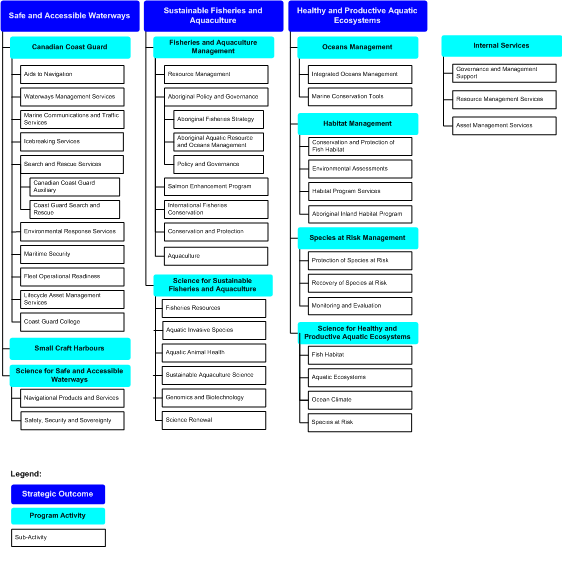
Program Activity Architecture: Long Description
DFO at a Glance
Our VisionExcellence in service to Canadians to ensure the sustainable development and safe use of Canadian waters |
Raison d'être
Canada's fisheries and oceans have played an important role historically, economically, and culturally in Canada's development and growth as a nation. Today, however, these fisheries and oceans face a number of challenges, including the collapse of key stocks, market changes, and environmental challenges such as pollution and climate change. In addition, DFO must be responsive to Aboriginal and treaty rights.
Fisheries and Oceans Canada (DFO) plays the lead role in managing and safeguarding Canada's aquatic resources. Ensuring safe, healthy, and productive waters and aquatic ecosystems for the benefit of present and future generations is the essence of the Department's activities. The Department's work is built around three strategic outcomes:
- Safe and Accessible Waterways — providing access to Canadian waterways and ensuring the overall safety and integrity of Canada's marine infrastructure for the benefit of all Canadians;
- Sustainable Fisheries and Aquaculture — delivering an integrated fisheries and aquaculture program that is credible, science based, affordable, and effective and contributes to sustainable wealth for Canadians; and
- Healthy and Productive Aquatic Ecosystems — ensuring the sustainable development and integrated management of resources in or around Canada's aquatic environment and carrying out critical science and fisheries-management activities.
| Strategic outcomes are the long-term and enduring benefits that Canadians derive from the Department's vision and efforts. |
DFO's Mandate
On behalf of the Government of Canada, DFO is responsible for developing and implementing policies and programs in support of Canada's scientific, ecological, social, and economic interests in oceans and fresh waters.
The Canadian Coast Guard (CCG), a Special Operating Agency within DFO, is responsible for services and programs that make a direct contribution to the safety, security, and accessibility of Canada's waterways. The Agency also contributes to the objectives of other government organizations through the provision of a civilian fleet and a broadly distributed shore-based infrastructure.
The Department's guiding legislation includes the Oceans Act, which charges the Minister with leading integrated oceans management and providing coast guard and hydrographic services on behalf of the Government of Canada, and the Fisheries Act, which gives the Minister responsibility for the management of fisheries, habitat, and aquaculture. The Department also shares, with Environment Canada and Parks Canada, responsibility for the Species at Risk Act, which charges the Minister with the responsibilities associated with the management of aquatic species at risk in Canada.
Strategic Outcome(s) and Program Activity Architecture
Like all federal government departments, DFO reports to Parliament on the basis of its Program Activity Architecture (PAA). The PAA explains the relationship between the activities the Department undertakes and the three strategic outcomes it is working to achieve. The PAA describes how the Department manages the resources under its control to achieve intended results/outcomes.
PAA Crosswalk
The Department's PAA for 2009-2010 differs only slightly from that used in the 2008-2009 Report on Plans and Priorities:
- In the 2008-2009 PAA, Aquaculture and Fisheries Management were separate program activities. In the new PAA, they are combined into a single program activity called Fisheries and Aquaculture Management.
- The 2009-2010 PAA also saw the addition of the new program activity, Species at Risk Management. In the 2008-2009 RPP, funding for this activity was included in the Habitat Management program activity.
- The sub-activity Species at Risk (Science) was moved from the Science for Sustainable Fisheries and Aquaculture program activity to the Science for Healthy and Productive Aquatic Ecosystems program activity.
The following shows resource allocations under the old and new PAAs.
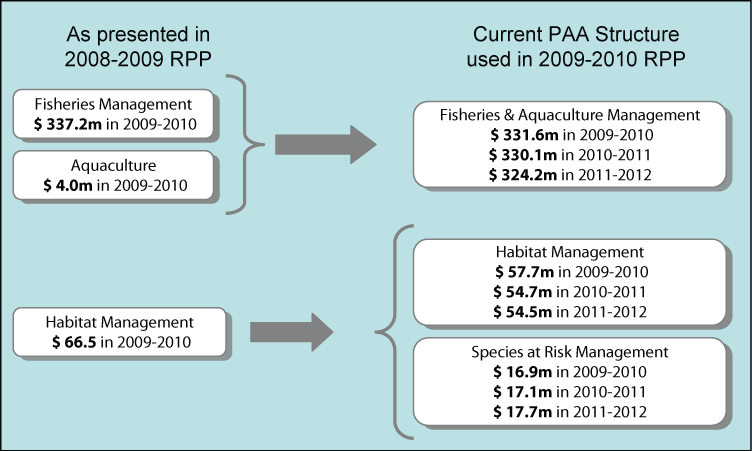
Program Activity Architecture: Long Description
Organization
Fisheries and Oceans Canada is a highly decentralized department, with more than eight of every ten employees located outside national headquarters. National headquarters, in Ottawa, establishes national objectives, policies, procedures, and standards for the Department, CCG, and six sectors — Fisheries and Aquaculture Management; Human Resources; Corporate Services; Oceans, Habitat and Species at Risk; Policy; and Science.
| For more information on how the Department is organized, see Organizational Structure. |
The Department's Regions
In addition to the National Capital Region, which serves as the Department's national headquarters, DFO has six regions, each headed by a Regional Director General (RDG).
Situated in regional headquarters, RDGs are responsible for delivering programs and activities in their regions in accordance with national and regional priorities and within national performance parameters. The Department operates fifteen regional science institutes, laboratories, and experimental centres across the country. Five DFO regions are home to CCG regional headquarters, which are headed by Assistant Commissioners responsible for the day-to-day delivery of Coast Guard services.
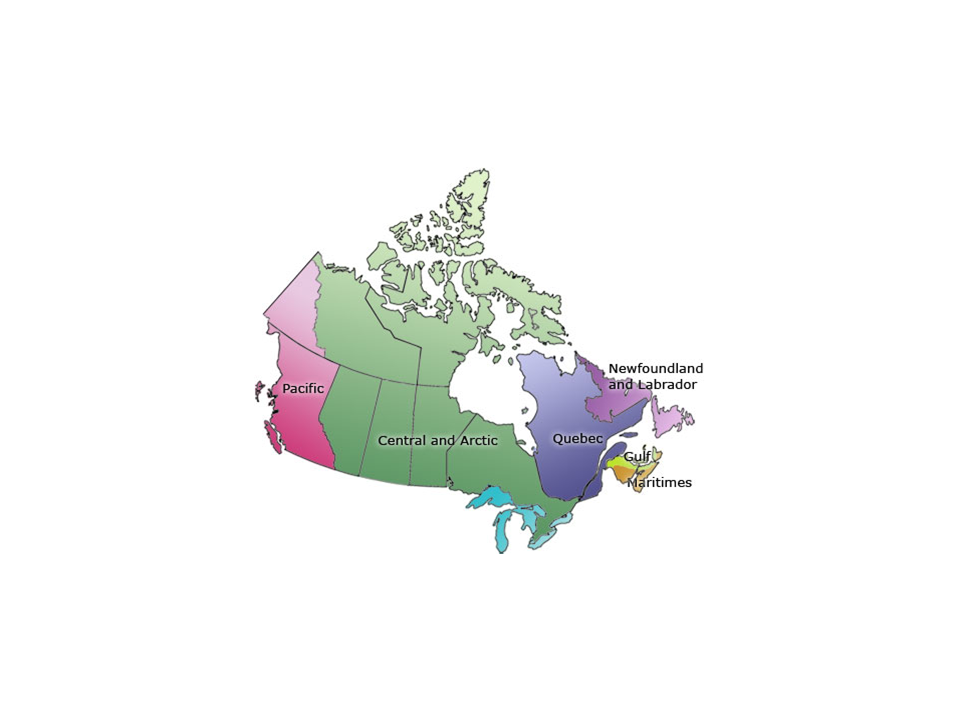
Newfoundland and Labrador
The Newfoundland and Labrador Region covers more than 28,900 km of coastline, 2.5m km2 of continental shelf, and three international boundaries. Almost 1,600 individuals, including 950 CCG personnel and over 180 Science personnel, deliver programs from regional headquarters in St. John's, three area offices, and about 40 detachment and satellite offices.
There are over 375 DFO-owned core fishing harbours in the region; these harbours, which are operated by Harbour Authorities, contain about 3,300 facilities. Regional CCG facilities include five Marine Communications and Traffic Services Centres, more than 1,700 fixed and floating aids to navigation, 55 lighthouses, and a fleet of 16 ships, 75 small craft, and three helicopters. Every year, the Maritime Rescue Sub-Centre in St. John's responds to about 500 incidents involving a total of 2,900 people.
| Newfoundland and Labrador Region has the most severe sea conditions in Canada, and its ice conditions are second in severity to those in the Canadian Arctic. |
Gulf
The Gulf Region includes all the waters of the Gulf of St. Lawrence adjacent to the eastern coast of New Brunswick, the Northumberland Strait coast of Nova Scotia and Western Cape Breton Island, and the whole of Prince Edward Island. Over 480 personnel serve Canadians from the regional office in Moncton, three area offices, and 20 field offices.
DFO owns 283 core fishing harbours in the Gulf and Maritimes regions, and Harbour Authorities in the Maritimes Region operate them.
The waters of this region represent about 1% of Canada's exclusive economic zone and account for approximately 20% of the total catch of Canada's fisheries. Gulf shares responsibility for the management of these fisheries with the Maritimes Region.
| Gulf is the only DFO region designated as bilingual: about half its staff are bilingual. |
Maritimes
The Maritimes Region extends from the northern tip of Cape Breton to the New Brunswick-Maine border, encompassing over 8,600 kilometres of coastline and adjacent marine areas. Approximately 2,400 full-time and seasonal staff work from the regional headquarters in Dartmouth, three area offices, and more than 100 other sites.
Harbour Authorities in the Maritimes Region operate the 283 DFO-owned core fishing harbours in the Gulf and Maritimes regions.
CCG activities for the region are administered from Dartmouth. CCG has operational bases in all three provinces, including three bases, nine search-and-rescue sites, three helicopter hangars, six helicopters, and 25 vessels.
The Canadian Hydrographic Service is responsible for hydrographic information for the entire Atlantic area, extending to the middle of the Canadian Arctic.
| The Maritimes Region is home to two renowned research stations: the Bedford Institute of Oceanography and the St. Andrews Biological Station. |
Québec
The Quebec Region, located within the borders of the province of Quebec, encompasses 6,000 kilometres of coastline. It consists of the St. Lawrence River, the estuary, and part of the Gulf, as well as the coastal waters of the Magdalen Islands. In Nunavik, it spans the eastern portion of James and Hudson Bay, the southern part of the Hudson Strait, as well as Ungava Bay.
This is the only unilingual French DFO region, and it has 1,400 employees, including 746 members of the CCG, distributed across 15 cities and communities.
With close to 4,000 commercial fish harvesters, the fishing industry remains an important economic engine for the marine sectors of Quebec. The region is home to 55 DFO-owned core fishing harbours, which are operated by Harbour Authorities.
The majority of programs and activities, including those of the CCG, are directed by the regional office, located in Québec City. The Maurice-Lamontagne Institute, a francophone marine science research centre located in Mont-Joli, is one of the most important federal science institutes in Quebec. Operating from 7 locations and assisted by a CCG Auxiliary of 656 members, CCG in the region operates a fleet of 24 vessels and aircraft.
| Over 70% of the population of Quebec resides along the St. Lawrence River up to the Gulf. This waterway, which extends 1,600 kilometres from the Atlantic Ocean to Montreal, has an impressive number of tributaries. Over 100 megatons of merchandise travel through the St. Lawrence River each year. |
Central and Arctic
DFO's largest region, Central and Arctic extends from Quebec to British Columbia — excluding the National Capital Region — and up through Canada's far north. It includes 71% of Canada's coastline, 67% of its fresh waters, and 65% of the country's marine waters. This region includes the Great Lakes, a key commercial and recreational waterway that supplies water to over 30 million people in Canada and the United States.
DFO shares some of its responsibilities for inland fisheries with the provinces and territories. Consequently, all regions work closely with the Department's provincial and territorial counterparts, as well as other resource management agencies, through formal partnerships, joint working arrangements, and shared work plans to ensure the effective understanding, management, and protection of aquatic ecosystems.
Some 1,500 individuals deliver programs from regional offices and the region's scientific research facilities. Central and Arctic's 600 CCG personnel, along with some 700 CCG Auxiliary members, deliver services from five Marine Communications and Traffic Services centres and almost 50 other CCG stations.
Harbour Authorities in Central and Arctic operate 54 DFO-owned core fishing harbours. Also, 7,100 fixed and floating aids to navigation help ensure that the region's waterways are safe and accessible.
| The region's fleet includes nine large vessels, 12 small vessels, three maritime security vessels, and two helicopters. Central and Arctic has operational control of six icebreakers from other regions during the Arctic navigational season. |
Pacific
The Pacific Region oversees 27,000 km of coastline, the inland fisheries of the Yukon Territory, 105 river systems in British Columbia, the rivers crossing the BC-Yukon border, and habitat in the BC interior; over 1,300 individuals work in the region's 40 offices and stations.
The 78 DFO-owned core fishing harbours in the Pacific Region are all operated by Harbour Authorities.
CCG Pacific Region is one of the largest regions in the Agency, with regional and fleet headquarters in Vancouver and Victoria respectively. Pacific Region's staff of more than 1,000 maintain and operate the region's many vessels, shore stations, helicopters, and marine aids.
| Science institutes include the Pacific Biological Station, the Institute for Ocean Sciences, the Center for Aquaculture and Environmental Research, and the Cultus Lake Salmon Research Laboratory. In addition, Pacific Region operates 14 major fish hatcheries. |
Strategic Context
To inform decisions on DFO's future directions, priorities, and business and human resources planning, the Department must take into account an increasingly complex and demanding policy and program environment that is characterized by interdependent domestic and global issues and risks.
DFO seeks to provide Canadians with the benefits of strong economic growth, knowledge and innovation, healthy environments, and safe and secure communities.
Economic growth that relies on a global economy necessitates marine trade. Safe and accessible waterways, modern navigation aids, hydrographic products and services, reliable small craft harbours, and collaborative partnerships with domestic and international stakeholders all contribute to this objective. Working with other nations to facilitate trade and marine commerce requires a sound strategy with regard to international engagement.
Healthy and productive aquatic ecosystems are the basis for sustainable fisheries and other marine enterprises that provide economic benefits for Canadians. Sustained use of our aquatic resources necessitates a thorough understanding of the resources and the ecosystems within which they exist, robust conservation and protection measures, and effective environmental response to emergencies. Continued work on the identification, protection, and recovery of species at risk is essential to maintaining the integrity and biodiversity of our aquatic ecosystems and the future sustainability of our resources.
Environmental impacts of climate change include changes in sea levels, changes in water characteristics, and diminishing ice cover. While this offers possibilities for emerging fisheries and off-shore natural resource development, it also presents risks to habitats and ecosystems and increases the threat posed by invasive aquatic species.
As Canada's Arctic is a maritime domain of territorial coasts, waterways, islands, and seas, DFO plays an important role in Northern economic development, sovereignty, and stewardship. Sea-ice depletion is changing the conditions for marine traffic and offers the prospect of new navigation routes in Canada's north, bringing about a need for new hydrographic data and navigational charts, new harbour facilities, and an increased presence to provide search and rescue and emergency environmental response.
The development of the Arctic's rich resource base requires both a broader scientific understanding and the protection of these unique ecosystems. Adapting to this combination of environmental and human impacts presents important challenges for many of the Department's program activities.
Being heavily reliant on global markets, Canada's seafood sector is directly affected by the weakening global economy. Decreasing access to capital for individuals and businesses affects who can participate in fisheries and influences the level and manner of that participation. Furthermore, an internationally competitive fishery must anticipate and adapt to market pressures, including technical trade standards such as eco-labelling and traceability and increasing competition from lower-cost international processors.
Global economic difficulties continue to put pressure on Canada's aquatic resources and make their conservation and protection even more important. Fisheries Renewal, with an emphasis on modernizing the Fisheries Act, will be a key priority of the Department. To capitalize on the economic benefits of our aquatic resources — both wild and farmed — we must work to ensure that Canadian fisheries products have access to increasingly restrictive global markets. Improving the governance of the aquaculture industry and providing market access are key priorities.
A safe marine environment and the provision of maritime services to Canadians, other federal departments, and other organizations helps to provide safe and secure communities, northern development, and arctic sovereignty. The Canadian Coast Guard, as a Special Operating Agency, focuses strongly on rejuvenation — replacing its aging infrastructure, improving management and maintenance, and focusing on its people — while continuing to provide service to Canadians, the Department, and others through a versatile fleet and shore-based infrastructure.
Recent scientific and technological innovations offer the potential for improvements in data acquisition and communications, while advances in fields such as resource extraction put more pressure on the Department to provide timely and reliable scientific support for environmental assessments.
Effective policies, programs, and resource management are all supported by knowledge of the oceans, inland waters, and aquatic species and ecosystems. Strong scientific research and monitoring programs are the basis of that knowledge. The Department's Science Program must ensure that its efforts are aligned with the information needs of the decision-makers of today and are able to adjust to emerging issues and the knowledge requirements of tomorrow.
Exponential growth in knowledge transfer and connectivity has fundamentally changed how people and organizations interact, requiring more openness, transparency, engagement, and accountability in the development and implementation of policies and programs. Collaborative partnerships with the provinces, territories, international interests, Aboriginal interests, and industry will allow the Department to meet its objectives while leveraging its resources. A sound strategy with regard to international engagement will allow Canada to work with other nations to protect shared resources.
The Department is committed to efficient and effective modern management — human resources modernization, business security and continuity, proactive information management, and strong asset management are all key to ensuring that the Department is able to provide results for Canadians.
Fisheries and Oceans Canada is committed to delivering effective and resilient programs and services that support environmentally sustainable and internationally competitive marine, fisheries, and aquaculture sectors; healthy aquatic ecosystems; and maritime safety and security. To respond to the potential risks and opportunities related to meeting this commitment, the Department will focus on the following priorities over the three-year planning period starting in 2009-2010.
| Key Operational Priorities | Ongoing Priorities |
|---|---|
|
|
| Management Priorities | |
|
|
Taken together, the Department's priorities support environmentally sustainable and internationally competitive fisheries, marine commerce, and healthy environments that contribute to the economic prosperity of our country. The Department is committed to designing and delivering its programs and services in a collaborative, transparent, and accountable manner.
Planning Summary and Departmental Priorities
| Departmental Planned Resources | |||
|---|---|---|---|
| 2009-2010 | 2010-2011 | 2011-2012 | |
| $ Millions | 1,858.9 | 1,983.3 | 2,010.2 |
| FTEs | 10,808 | 10,916 | 10,923 |
Future-oriented Financial Statements
As part of the government's commitment to implementing accrual budgeting and appropriations, DFO is participating in a pilot project to prepare future-oriented financial statements as a first step toward accrual budgeting. These forecasts will be aligned with the financial statements of the Departmental Performance Reports (DPRs), which are already prepared on an accrual basis, to permit meaningful comparison and analysis.
Departmental Planned Spending
The table showing the details of departmental planned spending by strategic outcome and program activities, along with the alignment to Government of Canada outcomes, can be found in the financial analysis at the end of this section. This placement permits a better discussion and explanation of the financial information contained in the table.
| For more Information, see DFO's future-oriented financial statements. | 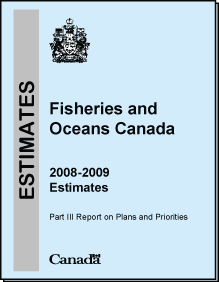 |
| Contribution of Operational Priorities to Strategic Outcomes | |
|---|---|
|
Fisheries Renewal
Fisheries Renewal is a three-year initiative to put in place policies, tools, and mechanisms to support a robust and diverse fisheries sector to benefit all Canadians. Fisheries Renewal is developing an enabling, transparent governance system to allow resource users and those with an interest in the resource to affect or to make decisions in support of their economic prosperity, while ensuring sustainability of the resource. In the long term, Fisheries Renewal will provide an integrated fisheries program that is credible, science-based, affordable, and effective and that contributes to sustainable prosperity for Canadians. |
Prior Commitment |
Key Operational Priority Contributing To:
|
Why
DFO is responsible for regulating harvesting activities to conserve the resource while providing sustainable economic opportunities. Key Plans
|
|
Northern Strategy
In support of the Government's Northern Strategy, DFO is working to develop an integrated approach to its role in Canada's Arctic. |
Prior Commitment |
Key Operational Priority Contributing To:
|
Why
Retreating polar ice, rising global demand for resources, and the prospect of year-round shipping are creating new challenges and opportunities for the North. DFO's activities play an important role in northern commerce, safety and security, sustainable resource development, and the understanding and protection of Arctic ecosystems and habitats. Key Plans
|
|
International Agenda
DFO's integrated approach to international fisheries and oceans identifies risks and opportunities globally, and influences the international agenda to protect and advance Canadian interests. DFO's international agenda seeks to ensure sustainable fisheries, the sustainability of marine environments and ecosystems, improved science-based decisions and policies, and international trade and business development throughout the fish and seafood value chain (fish harvesters, buyers/brokers, processors, marketing boards, distributors, and exporters). |
Prior Commitment |
Key Operational Priority Contributing To:
|
Why
DFO's international agenda is an area of growing importance. Increasingly, the international agenda influences domestic actions and presents opportunities to promote Canadian principles of sustainability. Key Plans
|
|
Health of the Oceans
Through its role in the Health of the Oceans initiative, DFO will support the establishment of a national system of Marine Protected Areas (MPAs), the designation of six new MPAs under the Oceans Act, additional science advice related to marine protection, the creation of four new virtual Oceans Centres of Expertise, and enhanced capacity to respond to oil spills in the Arctic Ocean. |
Prior Commitment |
Key Operational Priority Contributing To:
|
Why
DFO needs to strengthen its ability to prevent, detect, and reduce pollution; better protect ecologically significant marine areas; enhance co-operation with provincial/territorial, Aboriginal, domestic, and international partners; and better understand the oceans. The Government will also be increasing its scientific and conservation and protection activities in Canada's Arctic waters. Key Plans
|
|
Canadian Coast Guard Rejuvenation
CCG remains committed to delivering its services to mariners in Canadian waters by establishing clear, realistic priorities and ensuring sufficient resources are in place to deliver those services. |
Prior Commitment |
Ongoing Priority Contributing To:
|
Why
Coast Guard needs to continue to transform marine services through technology-based productivity improvements, client-service innovations, alternative service delivery, and greater use of partnering to secure a sustainable service-delivery model. Key Plans
|
|
Science Renewal
Science Renewal involves the development and implementation of initiatives that will ensure the Department's science base is aligned with the knowledge requirements of policy and decision-makers today while anticipating future science-based issues. The intent is to strengthen the ability of the Science Program to provide credible, relevant, and timely information to guide the development of policies and programs. |
Prior Commitment |
Ongoing Priority Contributing To:
|
Why
Timely, relevant, and valued science advice is needed to support public-policy development and decision-making within DFO and across all levels of government. Key Plans
|
|
Sustainable Aquaculture
Aquaculture continues to demonstrate tremendous potential for growth, as the global demand for fish and seafood exceeds the production capacity of wild fisheries. Sustainable Aquaculture will position the industry for enhanced profitability, self-sufficiency, and international competitiveness. |
Prior Commitment |
Ongoing Priority Contributing To:
|
Why
The Canadian aquaculture industry has the potential to become economically sustainable, environmentally responsible, and internationally competitive. Key Plans
|
|
Small Craft Harbours
The Small Craft Harbours (SCH) Program provides harbour infrastructure to the commercial fishing industry. |
Prior Commitment |
Ongoing Priority Contributing To:
|
Why
A safe and functional harbour infrastructure, combined with strong and viable local management of harbours, will over time increase the capacity to generate harbour revenues locally. This will in turn create socioeconomic benefits for the commercial fishing industry and local communities. Key Plans
|
|
Market Access
To maintain or increase market access, the export fish and seafood industry and government departments that regulate and enable their activities must now demonstrate, with supporting scientific evidence, that fish and seafood products are safe and are derived from sustainably managed and legal fisheries. The federal government must also ensure an adaptable, transparent, and predictable international framework of rules and standards that enables producers and consumers to have access to growing world markets. |
New Commitment |
Key Operational Priority Contributing To:
|
Why
The export fish and seafood industry is facing serious economic and environmental challenges in the form of new requirements for access to current and potential markets. Canada does not yet have in place the fully integrated traceability system needed to meet these requirements. Fish- and seafood-producing countries are facing an unprecedented number of international policy objectives that are being pursued through trade/market access measures (e.g., technical trade barriers). Negotiations are occurring in many parallel fora, and it is crucial that Canada take a lead in these negotiations to optimize access to markets for Canadian fish and seafood products, providing economic benefits and secure markets for our fisheries sector. Key Plans
|
|
Human Resources Modernization
Responding to the coming into force of all components of the new Public Service Modernization Act and the Public Service renewal plan of the Clerk of the Privy Council, the Department will work to modernize its human resource procedures to ensure that it has the right mix of human resources to deliver its programs and services. |
Prior Commitment |
Contributing To:
|
Why
The Department must respond to the coming into force of all components of the new Public Service Modernization Act (PSMA) and the government's Public Service Renewal Action Plan. Key Plans
|
|
Information Management and Information for Decision-making
DFO is establishing a five-year strategy for information management (IM). DFO is planning to adopt next-generation information solutions. The Department's vision for information is "Information used for decision-making and program delivery at DFO/CCG is accurate, relevant, comprehensive and timely." |
New Commitment |
Contributing To:
|
Why
This addresses the Government of Canada's priority of ensuring that high-quality and authoritative information is available for decision-makers. Key Plans
|
|
Asset Management
Modern aids to navigation, marine communications and traffic networks, vessels and other platforms, research facilities, shore installations, and small craft harbours are all costly assets that require special procurement, maintenance, and modernization. Many of these assets are nearing the end of their useful life or are at high risk of failure because of rust-out and capacity overload. |
Prior Commitment |
Contributing To:
|
Why
DFO has one of the largest capital asset bases of all federal departments and relies on an extensive and costly infrastructure to deliver its programs and services. Ensuring that this infrastructure meets departmental needs is critical to DFO's effectiveness. Key Plans
|
|
Security and Business Continuity
Under the leadership of DFO's Chief Information Officer, the IT Security Program ensures compliance with the spirit, intent, and mandated requirements of the Government Security Policy (GSP), the Government of Canada's Operational Security Standard: Management of Information Technology Security (MITS), and DFO's Integrated Risk Management Framework. Business Continuity Planning (BCP) helps ensure that Fisheries and Oceans will be able to continue to provide essential services to its clients and stakeholders even if the unexpected happens. In addition, the Emergency Management function works to provide appropriate responses to a wide variety of emergency situations. |
New Commitment |
Contributing To:
|
Why
In accordance with the Government Security Policy, the Departmental Security Officer (DSO) is responsible for all aspects of security and business continuity. DFO needs to protect employees, assets, information, and its IT infrastructure to satisfy Government of Canada security requirements and to ensure that Canadians have continued access to services. Key Plans
|
|
Partnering and Collaboration
Partnering and collaboration refers to collaborative arrangements between DFO and one or more parties (inside or outside government) where there is an explicit agreement to work cooperatively to achieve public-policy objectives. |
New Commitment |
Contributing To:
|
Why
DFO relies heavily on a broad range of suppliers, contractors, and third parties to support the delivery of its programs, and the Department continues to develop and sustain partnering arrangements that range from the very strategic to the very operational. Key Plans
|
Key Corporate Risks
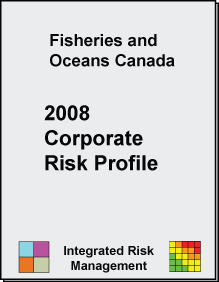

Key Corporate Risks: Long Description
DFO is committed to achieving its strategic outcomes and realizes that risks to those outcomes must be identified and mitigated as fully as possible. The Department has therefore developed and validated a corporate risk profile that identifies key risks and risk champions. The risk champions, members of the Departmental Management Committee, are accountable for risk mitigation, and identify risk-mitigation measures for each risk.
Risk champions determine the priorities for the risk-mitigation measures in their areas of responsibility; develop and coordinate the implementation of these measures; monitor the effectiveness of these measures; and ensure that risk management is integrated into planning and decision-making.
A fuller discussion of these risks and their mitigation strategy can be found in DFO's Corporate Risk Profile.
Expenditure Profile
| For the Main Estimates for all departments and agencies, see 2009-10 Part II - Main Estimates. | 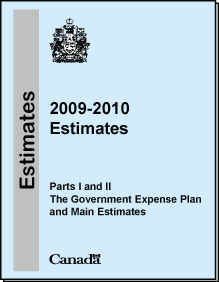 |
| Vote/Statutory Item (S) | Vote/Statutory Wording | 2009-2010 Main Estimates |
2008-2009 Main Estimates |
|---|---|---|---|
| 1 | Operating Expenditures | 1,167,689 | 1,178,250 |
| 5 | Capital Expenditures | 242,667 | 294,650 |
| 10 | Grants and Contributions | 110,637 | 90,461 |
| (S) | Minister of Fisheries and Oceans Canada salary and motor car allowance | 78 | 76 |
| (S) | Contributions to Employee Benefit Plans | 120,446 | 118,555 |
| Total - Fisheries and Oceans Canada | 1,641,517 | 1,681,992 | |
Departmental Planned Spending
| For program activity descriptions, please access the Main Estimates online. For more information on these outcome areas, see Canada's Performance, an annual report to Parliament. |  |
| Safe and Accessible Waterways |
Contributing to Government of Canada outcome areas :
|
|||
| Measured by: Public's confidence in the safety and security of marine travel in Canada | Target: 90% | |||
| (millions of dollars) | Forecast 2008-2009 | Planned 2009-2010 | Planned 2010-2011 | Planned 2011-2012 |
|
637.2 | 701.1 | 792.7 | 961.9 |
|
99.8 | 192.8 | 246.7 | 116.8 |
|
39.0 | 35.3 | 38.2 | 32.0 |
| Subtotal | 776.0 | 929.2 | 1,077.6 | 1,110.8 |
| Sustainable Fisheries and Aquaculture |
Contributing to Government of Canada outcome areas :
|
|||
| Measured by: Year over year improvement in management and conservation of major stocks to support sustainable fisheries, as evidenced in growth of the sustainability index | Target: 4% | |||
| (millions of dollars) | Forecast 2008-2009 | Planned 2009-2010 | Planned 2010-2011 | Planned 2011-2012 |
|
348.0 | 331.6 | 330.1 | 324.2 |
|
165.3 | 139.7 | 135.7 | 140.3 |
| Subtotal | 513.3 | 471.3 | 465.8 | 464.5 |
| Healthy and Productive Aquatic Ecosystems |
Contributing to Government of Canada outcome areas :
|
|||
| Measured by: The sustainable development and integrated management of resources in or around Canada's aquatic environment through oceans, fish habitat, and species at risk management | Target: TBD | |||
| (millions of dollars) | Forecast 2008-2009 | Planned 2009-2010 | Planned 2010-2011 | Planned 2011-2012 |
|
20.2 | 16.4 | 15.7 | 15.1 |
|
71.0 | 57.7 | 54.7 | 54.5 |
|
n/a | 16.9 | 17.1 | 17.7 |
|
58.5 | 55.4 | 54.4 | 50.0 |
| Subtotal | 149.6 | 146.4 | 142.0 | 137.3 |
|
367.4 | 311.9 | 297.9 | 297.6 |
| Total | 1,806.3 | 1,858.9 | 1,983.3 | 2,010.2 |
1 In 2008-2009, Species at Risk Management was part of Habitat Management.
Note: The Department continues to refine its Performance Measurement Framework to provide meaningful measures and targets.
Note: Because of rounding, figures may not add to the totals shown.
Analysis
With respect to the Departmental Planned Spending table:
- Adjustments to the Annual Reference Level Update (ARLU) figures due to amounts received in Supplementary Estimates, further policy approvals, Treasury Board approvals, Budget 2009, and statutory adjustments have been allocated to their respective program activities.
- Budget 2009 provided DFO with additional funding in 2009-2010 and 2010-2011 for:
- $175 million for Canadian Coast Guard vessel acquisition and repair and overhaul
- $200 million for Small Craft Harbours repair and maintenance
- $17 million to accelerate the construction of Pangnirtung harbour
- Forecast spending in 2008-2009 for Species at Risk Management shows as zero, as this program activity was created a separate entity for the 2009-2010 fiscal year. Previously, funds for this activity were included in the Habitat Management program activity.
- The increases for funding for Small Craft Harbours in 2009-2010 and 2010-2011 represent funding for small craft harbour repair and maintenance throughout the country and funding for Pangnirtung harbour in support of Nunavut's emerging fisheries.
- The increase for funding for Canadian Coast Guard in 2009-2010 and 2010-2011 represents funding for fleet renewal, including funds to repair and overhaul 40 large vessels and to acquire a large number of new vessels, including 60 small crafts, 30 replacement environmental response barges, 5 lifeboats, and 3 replacement inshore science vessels.
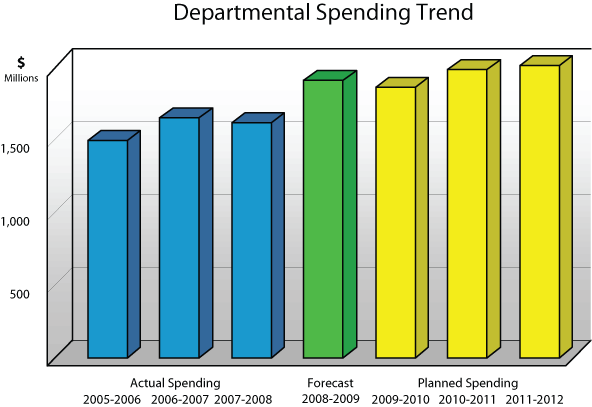
Departmental Spending Trend: Long Description
As the accompanying graph, Departmental Spending Trend, shows, departmental spending has remained fairly constant in recent years but will rise slightly between now and 2011 2012. This increase is due largely to new funding in the Safe and Accessible Waterways strategic outcome for fleet renewal for the Canadian Coast Guard and for enhanced small craft harbour maintenance and repair programs.
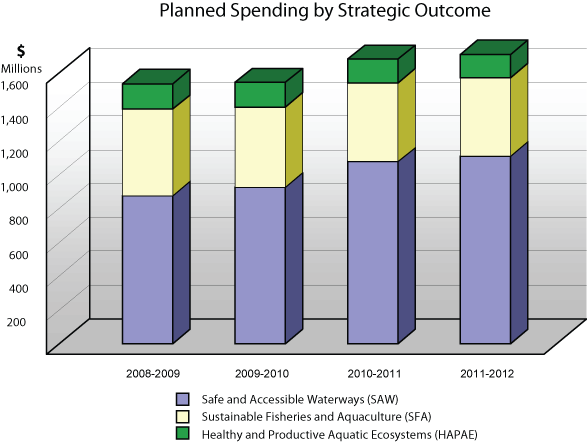
Planned Spending by Strategic Outcome: Long Description
The Planned Spending by Strategic Outcome graph clearly illustrates the increase in funding for Safe and Accessible Waterways.
The pie charts below compare the manner in which funds were allocated to strategic outcomes in 2008-2009 and 2009-2010. The allocation remained relatively constant, with the slight change in percentages being explained by the increased funding for Safe and Accessible Waterways noted above.
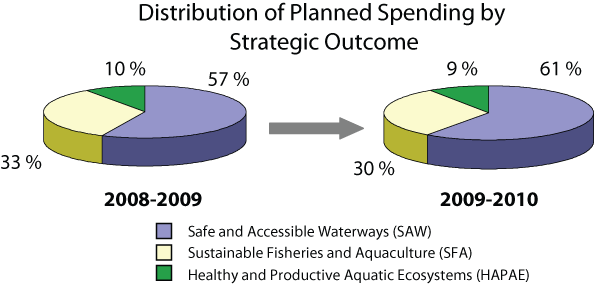
Distribution of Planned Spending by Strategic Outcome: Long Description
Note: In previous years, funding for the Internal Services program activity was identified under Program Enablers, and this funding was allocated to each of the Department's strategic outcomes. In line with new Treasury Board Secretariat directives, this funding is now displayed as a separate program activity independent of individual strategic outcomes, as it supports all of them.
